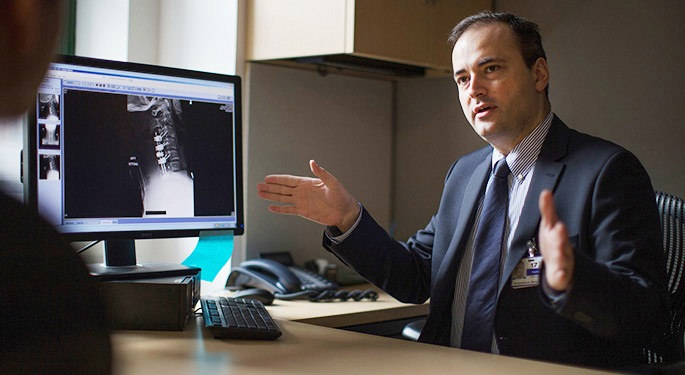Spinal Trauma

Trauma refers to an injury caused by a blow to the body. Spinal trauma is usually caused by motor vehicle collisions and falls, often from a great height. It usually produces pain in the back or neck; pain, weakness, or numbness in an arm or leg; and paralysis. Fractures, dislocations, deformity, or spinal cord injury also occur commonly with spinal trauma. Less common are spinal instability, a structural weakening of the spine, and neurological disability.
Risk factors for spinal trauma are high-speed motor vehicle collisions, falls, advanced age, and osteoporosis. As a result, young adults and the elderly are the most frequently affected by spinal trauma. If you already have a spinal tumor or osteoporosis, minor blows to the spine can further weaken your bones.
To prevent spinal trauma, it helps to maintain strong, healthy bones may offer protection and to avoid high-risk behaviors such as speeding, drinking and driving, diving into shallow water, or climbing high ladders. Unfortunately, we cannot always predict or prevent spinal trauma.
Diagnosis and Treatment of Spinal Trauma
At the Mount Sinai Health System, we give all patients with spinal trauma a thorough physical examination, including all organ systems by a multidisciplinary team of trauma specialists. We may also conduct imaging scans such as X-rays, a CT scan, or an magnetic resonance imaging (MRI). Our goal is to determine whether you have a complete or incomplete spinal cord injury.
We use this information to develop a treatment plan specific to your needs. If you are stable enough for spinal treatment, we will determine whether decompression, fusion, or bracing is appropriate. Decompression involves removing any bone, disc, or a blood clot that is pushing on a nerve or the spinal cord. Fusion includes stabilizing the bones of your spine (vertebrae) that are structurally weak or have too much abnormal motion. Usually, we implant titanium rods and screws into your back. We can do either of these procedures through traditional "open" surgery or a minimally invasive procedure.
Another option is bracing, which means supporting the spine with externally placed collars, braces, or traction. We can use this as a permanent treatment or as a temporary measure until you are stable enough for surgery.
Spinal Trauma Rehabilitation
Over the past few years, there has been incredible growth in the technologies available to stabilize the spine after trauma. These approaches make it easier to recover and progress to rehabilitation relatively quickly. We at Mount Sinai are proud to offer a comprehensive inpatient rehabilitation hospital with a dedicated spinal trauma unit. We tailor rehabilitation programs to help you improve as much, and as quickly, as possible.
Please visit our Spinal Cord Injury Rehabilitation Program for more information.